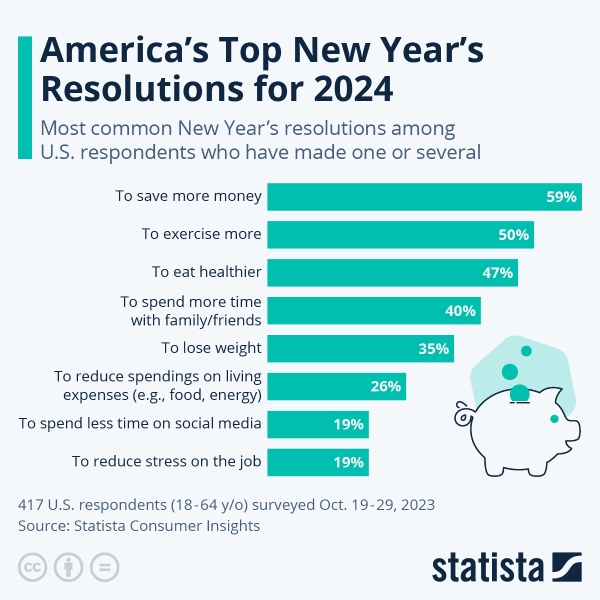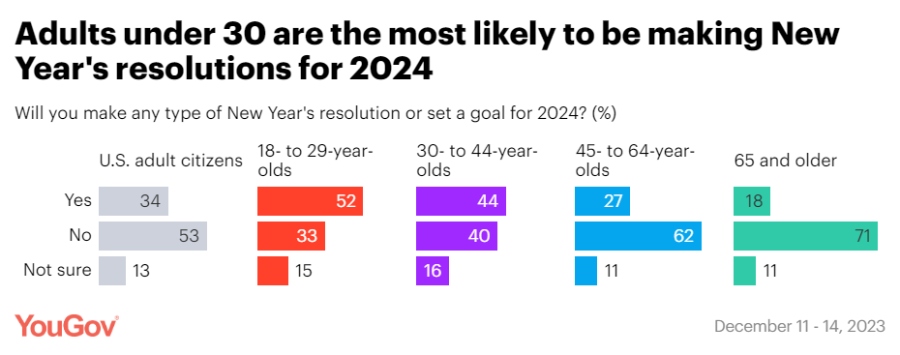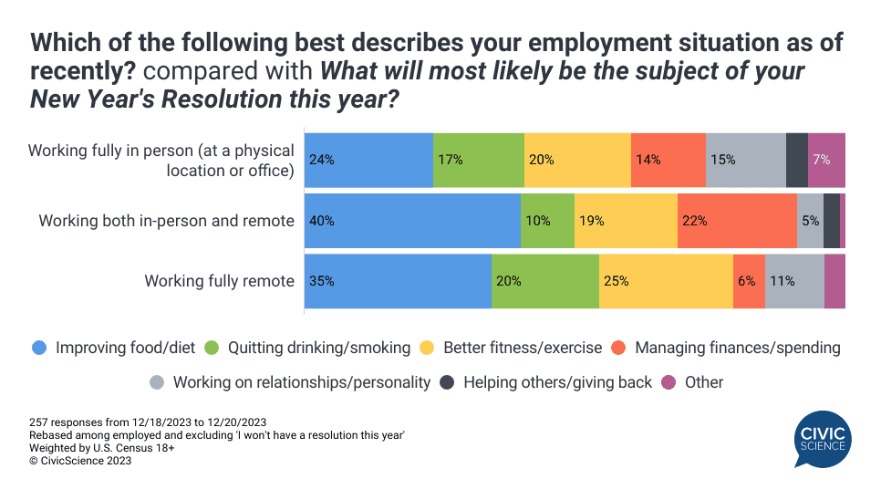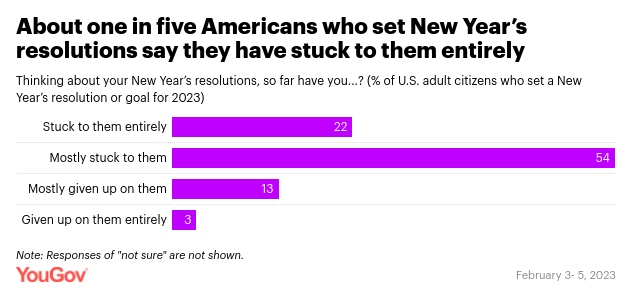New Year’s resolutions are a popular way to approach self-improvement and achieve goals. These commitments are heavily influenced by cultural and economic trends and have a significant impact on early-year spending.
These New Year resolution statistics for consumers break down the 2024 goal landscape with trends, demographics, and insights into the psychological drivers that shape success rates— plus sales and marketing strategies to engage resolution-focused consumers.
Key New Year Resolution Consumer Statistics Takeaways:
- The top 2024 New Year’s resolutions revolve around money, health, and physical fitness
- 58% of US adults are committed to a resolution this year
- Adults under 30 and those with hybrid work environments are the most likely to make resolutions
- Aspects like specificity and “streak” maintenance are some of the biggest contributors to goal success
New Year’s Resolution Trends
1. Saving money is the No. 1 New Year’s resolution for 2024 in the US
Economic pressures are leading to a surge in cost-consciousness, making saving money the most popular goal for Americans in 2024. The next top New Year’s resolutions include exercising more, eating healthier, and spending more time with family and friends.
Retailers and small business owners can respond to the consumer trend of financial mindfulness by focusing their marketing on value and offering budget-friendly products.

2. One in four US adults plans to reduce their spending on essential living costs
Another popular 2024 resolution is reducing spending on living expenses. According to Statista, 26% of adults aim to cut down on the cost of basic necessities, such as food, utilities, housing, and transportation, in the coming year.
This trend prompts businesses like grocery stores and restaurants to consider emphasizing cost-saving options like value meals and bulk purchase discounts.
Similarly, retailers offering energy-efficient products can focus on marketing the long-term cost savings of these items, which resonates with consumers looking to cut down on their energy bills.
3. The top UK 2024 New Year’s resolution is getting more exercise
In the UK, a push toward health and financial security is clear, with the top UK New Year’s resolutions being more exercise (49%), better saving (47%), healthier eating (42%), and weight loss (36%).
4. Over half of US adults have committed to a 2024 resolution
This year, 58% of US adults have set a 2024 New Year’s resolution, a slight dip from last year’s 61%.
Even with this decrease, over half of the adult population continues to prioritize goal-setting as they enter the new year, signaling a sizable market for fitness equipment, health and wellness products, hobby supplies, and budget goods.
Related: Best Products to Buy & Sell for Profit
5. More than 61% of people feel pressured to set one or more New Year’s resolutions
A Forbes Health/OnePoll survey reveals that 61.7% of respondents feel pressured to set New Year’s resolutions, and 66.5% plan to tackle three or more resolutions in the coming year.
This information can guide businesses to tailor their strategies, focusing on products and messaging that resonate with those juggling multiple resolutions, and potentially easing the associated pressure.
6. New goals are the most popular resolutions, but second-tries still hold a share
In a recent survey, about 24% of respondents reported planning to set the same resolution they’ve had in previous years, while 29% had chosen similar ones before. Meanwhile, nearly half of the respondents had new resolutions in mind.
This New Year resolution consumer statistic suggests that a significant portion of consumers seek familiarity, but there’s an overwhelming appetite for new experiences.
7. 23% of people in the US are interested in participating in ‘Dry January’
Dry January, an initiative to abstain from alcohol at the start of the year, is a growing trend across the globe. In the UK and Australia, 31% expressed a high likelihood of participating in 2024, followed by 26% in Canada, and 23% in the US.
The January sobriety movement offers retailers a chance to focus on mocktail ingredients and alcohol alternatives to cater to the increasing customer interest. Similarly, bars and restaurants can use this opportunity to promote non-alcoholic offerings on their menu.
Related:
New Year’s Resolution Demographic Statistics
8. Younger adults are over twice as likely to make resolutions compared to those aged 45+
Among different age groups, adults under 30 are the most inclined to set 2024 New Year’s resolutions, with 52% planning to do so. This is followed by the 30- to 44-year-old demographic, where 44% plan to make resolutions.
In contrast, only 27% of 45- to 64-year-olds and a mere 18% of those 65 and older are likely to set New Year’s resolutions, showing the importance of tailoring your retail marketing of resolution-related products and services to younger generations.

Learn more about marketing across age cohorts:
- Ultimate Guide to Generational Marketing
- Gen X Consumer Behaviors
- Millennial Shopping Habits
- Gen Z Consumer Behavior
9. Work environment has a significant impact on resolution choices
Individuals with hybrid jobs (a mix of in-person and remote work) are the most inclined to set New Year’s resolutions.
Those with fully in-person jobs are less likely to set resolutions, but when they do, they tend to focus more on relationships. In contrast, hybrid workers are most interested in improving their food and diet habits, while fully remote employees are more inclined to concentrate on fitness goals compared to others.

New Year’s Resolution Success & Failure Rates
10. 22% of Americans think they have maintained their goals by February
By February 2023, about one in five Americans said they had stuck to their New Year’s resolutions entirely, while 54% said they had mostly stayed on track. Meanwhile, another 13% had mostly given up, and 3% said they had quit entirely.

11. 80% of people start losing motivation on “Quitters Day,” which will be Jan. 12 in 2024.
In contrast to goal-setters’ perceptions, reports from Strava paint a different picture. Beginning in 2019, continued studies reveal that around 80% of individuals who set New Year’s resolutions begin to drop them by the second week of January.
Analyzing over 800 million user-logged activities through its app, Strava identified the second Friday (falling on Jan. 12 this year) as the key day when many people’s motivation for their New Year’s resolutions begins to fade.
12. At the beginning of the year, 43% don’t expect their goals to last beyond February
Despite many having an overly optimistic perspective later in the year, early January survey findings show that people often go into their goals with a more pessimistic mindset. Around 43% expect to drop them by February, and only 10% think they’ll last beyond three months. This could be influenced by a realistic assessment of personal willpower and past experiences with failed New Year’s resolutions.
New Year’s Resolution Psychology Insights
13. There are two types of resolutions, and the most popular one is 24 times more effective
Approximately 88% of New Year’s resolutions are approach-oriented, meaning they focus on adopting new behaviors or achieving new goals. On the other hand, just 11.3% are avoidance-oriented, meaning they center on stopping or avoiding certain behaviors.
This distinction is crucial, as data reveals that approach-oriented resolutions are 24 times more effective.
14. Specific, challenging goals improve success in 90% of cases
Studies have found that more targeted and challenging goals lead to higher performance in 90% of cases, compared to setting easy, “do your best,” or vague goals. This principle is especially relevant for New Year’s resolutions, where setting clear and ambitious targets can significantly increase the likelihood of achieving them.
15. Efforts to maintain a ‘streak’ have a big impact on resolution outcomes
According to new research from Clemson University, the key to sticking with a resolution often lies in maintaining a “streak,” which gives a sense of progress and achievement.
This insight highlights the benefits of not only offering products that aid in habit formation, like water bottles and fitness trackers, but also using omnichannel tactics such as friendly email reminders or regular social media posts to help customers keep up with their positive streaks.
Related:
Frequently Asked Questions (FAQs)
An example of a New Year’s resolution is saving money, often broken down into steps such as setting a budget, reducing non-essential spending, increasing home-cooked meals, and cutting coupons. Another common resolution is losing weight, typically through a dedicated exercise and diet regimen.
New Year’s resolutions commonly fail because they are often too ambitious, vague, or focused solely on outcomes rather than processes. This leads to a high failure rate, with many resolutions falling by the wayside as early as mid-January or February.
Bottom Line
The 2024 New Year’s resolution statistics for consumers highlight a strong interest in financial and physical health, with over half of US adults setting goals in these areas. This suggests a big market for products and services that support building habits and staying on track with goals.
Businesses that adjust their strategies in line with New Year resolution consumer statistics can connect with goal-focused customers and improve sales going into the new year.